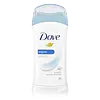Nivea Black & White Invisible Silky Smooth Anti-Perspirant Versus Dove Original Invisible Solid Antiperspirant Stick
What's inside
What's inside
 Key Ingredients
Key Ingredients

 Benefits
Benefits

 Concerns
Concerns

 Ingredients Side-by-side
Ingredients Side-by-side

Water
Skin ConditioningAluminum Chlorohydrate
AstringentPPG-14 Butyl Ether
Skin ConditioningCetyl Palmitate
EmollientHydrogenated Castor Oil
EmollientC12-15 Alkyl Benzoate
AntimicrobialCetearyl Alcohol
EmollientPropylene Glycol
HumectantPalmitic Acid
EmollientStearic Acid
CleansingParfum
MaskingAluminum Sesquichlorohydrate
AstringentC20-40 Alkyl Stearate
Skin ConditioningOleth-20
CleansingPalmitamidopropyltrimonium Chloride
Steareth-2
EmulsifyingSteareth-21
CleansingMyristic Acid
CleansingArachidic Acid
CleansingOleic Acid
EmollientPentaerythrityl Tetra-Di-T-Butyl Hydroxyhydrocinnamate
AntioxidantBHT
AntioxidantAlpha-Isomethyl Ionone
PerfumingCitronellol
PerfumingBenzyl Alcohol
PerfumingBenzyl Salicylate
PerfumingWater, Aluminum Chlorohydrate, PPG-14 Butyl Ether, Cetyl Palmitate, Hydrogenated Castor Oil, C12-15 Alkyl Benzoate, Cetearyl Alcohol, Propylene Glycol, Palmitic Acid, Stearic Acid, Parfum, Aluminum Sesquichlorohydrate, C20-40 Alkyl Stearate, Oleth-20, Palmitamidopropyltrimonium Chloride, Steareth-2, Steareth-21, Myristic Acid, Arachidic Acid, Oleic Acid, Pentaerythrityl Tetra-Di-T-Butyl Hydroxyhydrocinnamate, BHT, Alpha-Isomethyl Ionone, Citronellol, Benzyl Alcohol, Benzyl Salicylate
Ingredients Explained
These ingredients are found in both products.
Ingredients higher up in an ingredient list are typically present in a larger amount.
BHT is a synthetic antioxidant and preservative.
As an antioxidant, it helps your body fight off free-radicals. Free-radicals are molecules that may damage your skin cells.
As a preservative, it is used to stabilize products and prevent them from degrading. Specifically, BHT prevents degradation from oxidation.
The concerns related to BHT come from oral studies; this ingredient is currently allowed for use by both the FDA and EU.
However, it was recently restricted for use in the UK as of April 2024.
Learn more about BHTC12-15 Alkyl Benzoate is made up of Benzoic Acid and long chain alcohols. It has a low molecular weight.
C12-15 Alkyl Benzoate is an emollient and texture enhancer. Due to its solubility, it is often used in sunscreens to help evenly distribute active ingredients.
As an emollient, C12-15 Alkyl Benzoate helps soften and hydrate your skin. Emollients create a film on your skin that traps moisture within.
This ingredient has been reported to cause eye irritation.
Learn more about C12-15 Alkyl BenzoateHydrogenated Castor Oil is created by adding hydrogen to castor oil. This helps stabilize the castor oil and raises the melting point. At room temperature, hydrogenated castor oil is solid.
Castor Oil helps moisturize the skin. It is rich in a fatty acid called ricinoleic acid. This fatty acid helps prevent moisture loss on the skin. This helps keep your skin soft and hydrated. Ricinoleic acid also has anti-inflammatory and pain reducing properties.
As a wax-like substance, Hydrogenated Castor Oil acts as an emollient. Emollients help keep your skin stay soft and smooth by creating a barrier. This barrier helps trap moisture.
Hydrogenated Castor Oil may not be fungal-acne safe. We recommend speaking with a professional.
Learn more about Hydrogenated Castor OilParfum is a catch-all term for an ingredient or more that is used to give a scent to products.
Also called "fragrance", this ingredient can be a blend of hundreds of chemicals or plant oils. This means every product with "fragrance" or "parfum" in the ingredients list is a different mixture.
For instance, Habanolide is a proprietary trade name for a specific aroma chemical. When used as a fragrance ingredient in cosmetics, most aroma chemicals fall under the broad labeling category of “FRAGRANCE” or “PARFUM” according to EU and US regulations.
The term 'parfum' or 'fragrance' is not regulated in many countries. In many cases, it is up to the brand to define this term.
For instance, many brands choose to label themselves as "fragrance-free" because they are not using synthetic fragrances. However, their products may still contain ingredients such as essential oils that are considered a fragrance by INCI standards.
One example is Calendula flower extract. Calendula is an essential oil that still imparts a scent or 'fragrance'.
Depending on the blend, the ingredients in the mixture can cause allergies and sensitivities on the skin. Some ingredients that are known EU allergens include linalool and citronellol.
Parfum can also be used to mask or cover an unpleasant scent.
The bottom line is: not all fragrances/parfum/ingredients are created equally. If you are worried about fragrances, we recommend taking a closer look at an ingredient. And of course, we always recommend speaking with a professional.
Learn more about ParfumWe don't have a description for PPG-14 Butyl Ether yet.